Reserve Bank of Australia Annual Report – 2016 Accountability and Communication
The Reserve Bank is an independent central bank, accountable to the Parliament of Australia for its actions. The Bank is required by legislation to consult with, and report to, the Australian Government. The Bank seeks to enhance the community's understanding of its responsibilities, policies and actions through a broad communication program.
Relationship with Government
The Reserve Bank is a body corporate distinct from the Commonwealth of Australia. This body corporate, established under the Commonwealth Bank Act 1911 and continued in existence under the Commonwealth Bank Act 1945, was preserved and continued in existence with the name Reserve Bank of Australia under the Reserve Bank Act 1959. The Governor, Deputy Governor and members of the Reserve Bank Board are appointed by the Treasurer. The Board is afforded substantial operational independence under the Reserve Bank Act to determine and implement the policies of the Bank, as will best contribute to the objectives set out in the Act. The Statement on the Conduct of Monetary Policy, as updated from time to time, has recorded the common understanding of the Governor, as Chair of the Reserve Bank Board, and the government on key aspects of Australia's monetary and central banking policy framework since 1996. The Statement on the Conduct of Monetary Policy, which seeks to foster a sound understanding of the nature of the relationship between the Reserve Bank and the government, records that the government recognises and continues to respect the Reserve Bank's operational independence.
The Reserve Bank's operational independence is accompanied by an obligation to inform the government of its monetary and banking policy ‘from time to time’. This obligation is discharged mainly by regular contact between the Governor and the Treasurer, who is the Bank's responsible Minister (at the date of signing, The Hon Scott Morrison MP, who succeeded The Hon Joe Hockey on 21 September 2015), usually by way of a discussion following Board meetings. The Reserve Bank Act sets out a clear process for managing differences of opinion between the Board and the government on policy matters.
Reporting Obligations
The Reserve Bank is a corporate Commonwealth entity under the Public Governance, Performance and Accountability Act 2013 (PGPA Act), of which the Governor is the ‘accountable authority’. Under section 46 of the PGPA Act, the Governor is responsible for the preparation of this annual report and for giving it to the Treasurer for presentation to parliament, following approval by the Reserve Bank Board of the Bank's annual financial statements. That approval was given by the Board at its meeting on 2 August 2016.
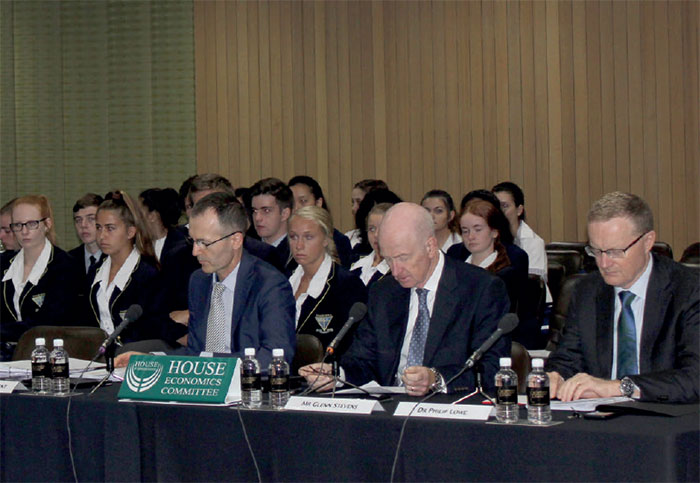
The House of Representatives Economics Committee has, in its Standing Orders, an obligation to review the annual report of the Reserve Bank and the annual report of the Payments System Board. The committee holds twice-yearly public hearings, at which the Bank presents its views on the economy and financial markets and other matters pertaining to the Bank's operations, and responds to questions from committee members. In 2015/16, the Governor and senior Bank officers attended hearings of this committee for this purpose in September 2015 in Canberra and in February 2016 in Sydney. The committee issued its reports on these hearings on 23 November 2015, Review of the Reserve Bank of Australia Annual Report 2014 (Second Report), which covered the September 2015 hearing, and on 13 April 2016, Review of the Reserve Bank of Australia Annual Report 2015 (First Report), which covered the February 2016 hearing.
The regular twice-yearly appearances before the House of Representatives Economics Committee and the quarterly Statement on Monetary Policy (see below) are important elements of the arrangements embodied in the understanding between the Governor and the Treasurer (outlined in the sixth Statement on the Conduct of Monetary Policy, which was issued in October 2013).
In addition to these appearances, the Reserve Bank made two public submissions to parliamentary inquiries during the year:
- in July 2016, an opening statement, in support of the June 2015 submission to the Inquiry into Home Ownership, at a hearing of the House of Representatives Standing Committee on Economics Inquiry into Home Ownership
- in August 2015, to the Senate Economics References Committee Inquiry into Matters relating to Credit Card Interest Rates.
In 2015/16, no report on the Reserve Bank was issued by the Commonwealth Ombudsman, the Office of the Australian Information Commissioner or the Auditor-General, apart from that dealing with the audit of the Bank's annual financial statements.

Communication
The Reserve Bank seeks to ensure a high degree of transparency about its activities, goals, decision-making processes and the basis of its policy decisions. Transparency facilitates the Bank's accountability, to accompany its operational independence. Importantly, it also increases the effectiveness of policy decisions by promoting a better understanding of those decisions across the wider community.
Minutes are released after each Reserve Bank Board meeting on monetary policy.
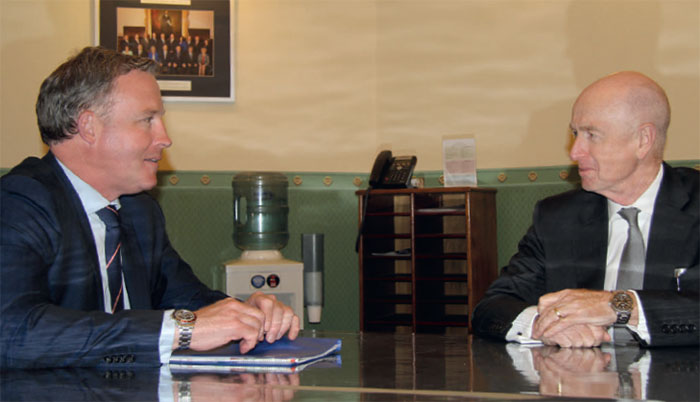
Tasmanian Premier Will Hodgman (left) and Governor Glenn Stevens (right) following a meeting of the Reserve Bank Board in Hobart, April 2016
Announcements about monetary policy decisions are also made immediately after each Reserve Bank Board meeting, and announcements are made about Payments System Board decisions as required. In addition, since November 2015 the Bank has published a media release immediately following Payments System Board meetings outlining issues discussed at the meeting and foreshadowing any forthcoming documents to be released by the Bank.
Feedback from stakeholder consultation is an important input to decision-making by the Reserve Bank. The Bank's consultation activities range from formal consultation processes associated with particular policy or operational decisions to ongoing engagement with a wide variety of groups, as described in the chapter on ‘Community Engagement’.
During the year in review, the Reserve Bank announced changes to the standards for card payment systems as determined by the Payments System Board. These changes were made on the basis of a wide-ranging review of card payments regulation, involving extensive consultation, conducted by the Bank following from some recommendations of the Financial System Inquiry. Further detail is provided in the 2016 Payments System Board Annual Report.
The Bank's broader communication program is outlined below.
Bank publications
The quarterly Statement on Monetary Policy provides information to the general public, financial markets and media about the Reserve Bank's views on monetary policy. It also provides a basis for the questioning of the Bank by the House of Representative Standing Committee on Economics. The Statement contains a detailed analysis of conditions in the economy and financial markets and describes the outlook for inflation and the economy more generally.
The Financial Stability Review, published semi-annually, provides a detailed assessment of the condition of Australia's financial system, along with analysis of financial system issues of special interest. In the year in review, these issues included discussion of Chinese demand for Australian property, developments in the financial system architecture, effects of low yields on life insurers and pension funds, and growth in banks' commercial property exposure. More generally, the Review reports on international regulatory developments and the Reserve Bank's involvement. In addition, the Review reports on domestic regulatory issues, including through the Bank's work with the Council of Financial Regulators (CFR), which is the coordinating body for Australia's main financial regulatory agencies.
The CFR is a non-statutory body whose role is to contribute to the efficiency and effectiveness of financial regulation and to promote stability of the Australian financial system. Its members – the Reserve Bank, Australian Prudential Regulation Authority (APRA), Australian Securities and Investments Commission (ASIC) and the Treasury – share information, discuss regulatory issues and, if the need arises, coordinate responses to potential threats to financial stability. The CFR also advises the Australian Government on Australia's financial regulatory arrangements.
Australia's financial stability policy framework includes mandates for financial stability for both APRA and the Reserve Bank. APRA is responsible for prudential supervision and the Bank is responsible for promoting overall financial system stability.
The Reserve Bank's quarterly Bulletin contains analysis of a broad range of economic and financial issues as well as aspects of the Bank's operations. During the year in review, Bulletin contained regular articles on the housing market, including changing trends and growth in apartment construction. Commodity prices and trends in emerging markets were examined, as was the Chinese economy, with articles on capital flows, trade data and demographic changes. In the lead-up to the issuance of the new $5 banknote, articles looked at the life of Australian banknotes and the Bank's stakeholder engagement activities. Articles also covered developments in banks' funding costs and banking fees, and developments in the labour market.
Speeches
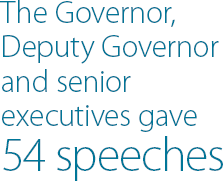
During 2015/16, the Governor, Deputy Governor and other senior officers gave 54 public speeches on various topics. Questions were taken after almost all speeches. Senior staff also participated in a number of public panel discussions. In addition to explaining current economic and financial conditions, speeches addressed the economic transition in China, developments in the foreign exchange markets and the development of a global code of conduct for the foreign exchange markets. There were also speeches on the evolution of the Australian payments system and continued analysis of the transition from the resources ‘boom’. Audio files of these speeches, the associated question and answer sessions and panel discussions were published on the Reserve Bank's website to improve accountability and communication.
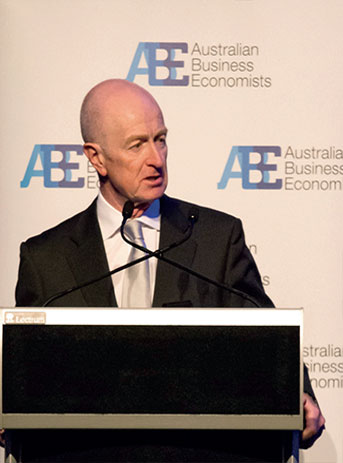
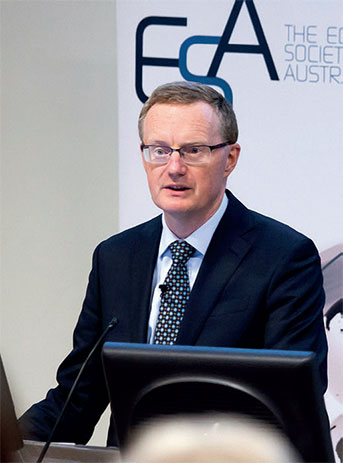 Photo: UWA Business School/Matthew Galligan
Photo: UWA Business School/Matthew Galligan
Research
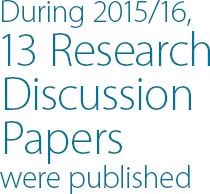
The Reserve Bank disseminates the results of longer-term research conducted by staff in the form of Research Discussion Papers (RDPs). The purpose of the RDP series is to encourage discussion and comment on policy-relevant issues. The views expressed in RDPs are those of the authors and do not necessarily represent those of the Bank. During 2015/16, 13 RDPs were published on a range of topics in the Bank's areas of interest, including housing wealth effects, measuring economic uncertainty and its effects, changes in the terms of trade and inflation expectations. Reserve Bank staff also published their research in various external journals, including the International Journal of Central Banking, The Australian Economic Review, the Australian Journal of Labour Economics, the Journal of Financial Stability, the Journal of Housing Economics, The Economic Journal and Oxford Economic Papers.
Research undertaken at the Reserve Bank is frequently presented at external conferences and seminars. In 2015/16, Bank staff presented at a number of conferences and institutions in Australia and overseas, including in the Chinese cities of Shenzhen and Xiamen.
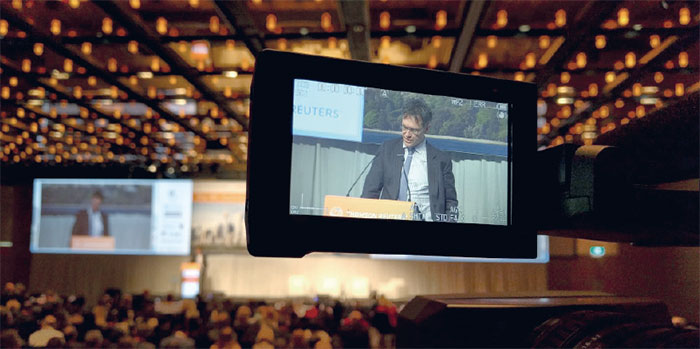

(Image top) Assistant Governor (Financial Markets) Guy Debelle at the fourth Australian Regulatory Summit, June 2016; (Image above) Alexandra Heath (Head of Economic Analysis Department) speaking at CEDA's NSW Energy Series 2016
The Reserve Bank hosts regular conferences, which foster interaction between academics, central bankers and other economic practitioners on topical policy issues. The Bank's annual conference for 2016 was held in March and focused on structural change in China and the implications for Australia. A volume containing the conference papers and discussions will be published in the second half of 2016. The next annual conference is scheduled for March 2017.
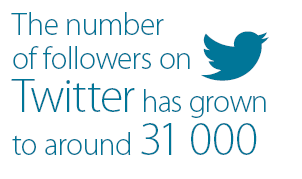
The Reserve Bank also hosted visits in 2015/16 from a number of policymakers from domestic and overseas institutions, including the Bank for International Settlements, Federal Reserve Bank of New York, People's Bank of China and Reserve Bank of New Zealand, as well as academics from a range of institutions, including Bruegel, Colombia University, Harvard University, Hitotsubashi University, Nuffield College, University of Michigan and University of Tokyo. During their visits, these visitors presented seminars, taught short courses and participated in research activities at the Bank.

Online communication
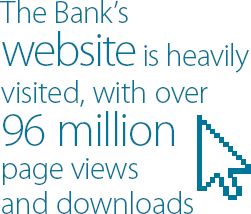
The Reserve Bank publishes information in both electronic and hard-copy formats, though most access to information is now online. The Bank's website is heavily visited, with over 96 million page views and downloads during 2015/16, and large spikes in visitation at the time of release of market-related information. The number of followers on Twitter has grown to around 31,000, while the number of subscribers to the website's conventional email alert service has continued to fall (to less than 10,500 at the end of June 2016). Visitors to the website also made use of the RSS feeds, which allowed them to receive alerts about updates to selected data, media releases, speeches, research papers and other documents (including those related to Freedom of Information requests).
Efforts to assist with public understanding of the Reserve Bank's role included the publication of videos on the Bank's main website and its YouTube channel. These videos address each of the Bank's roles and functions, along with activities related to the upcoming new banknote series, the Bank's Museum and recruitment.
In December 2015, a substantial upgrade of the Reserve Bank's main website was released. Apart from a more contemporary presentation and better navigation, a key feature of the upgraded website was its responsive functionality, in which the content is automatically resized for different mobile devices. The Banknotes microsite (www.banknotes.rba.gov.au), which focuses on explaining the design, production and security features of Australia's banknotes, was further developed as an education resource during the year in review to provide information to the public and key stakeholders about the new banknote series. (More detail is provided in the chapter on ‘Banknotes’.) In July 2016, the Banknotes microsite was also made responsive for ease of access to the content on a range of mobile devices.